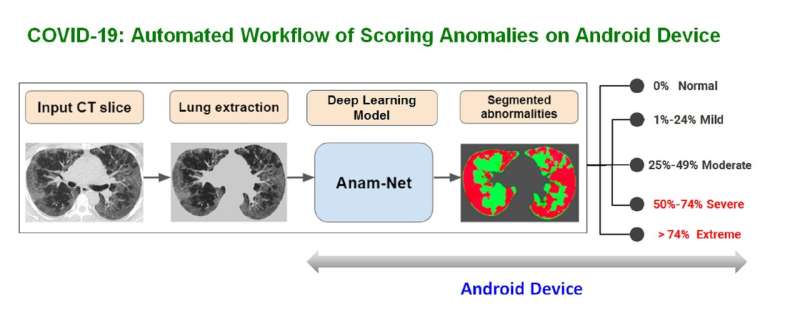Key steps in the proposed approach for automated segmentation of abnormalities/anomalies in chest CT images. Credit: IEEE
A new software tool that reveals the severity of lung infections in COVID-19 patients has been developed by researchers from the Departments of Computational and Data Science (CDS) and Instrumentation and Applied Physics at the Indian Institute of Science (IISc), in collaboration with colleagues from the Oslo University Hospital and the University of Agder in Norway. It has been described in a recent study published in the journal IEEE Transactions on Neural Networks and Learning Systems.
COVID-19 can cause severe damage to the respiratory system, especially the lung tissues. Image-based methods such as X-ray or CT scans can prove helpful in determining how bad the infection is.
The software tool developed by the IISc-led team, called AnamNet, can 'read' the chest CT scans of COVID-19 patients, and, using a special kind of neural network, estimate how much damage has been caused in the lungs, by searching for specific abnormal features. Such a tool can provide automated assistance to doctors and therefore help in faster diagnosis and better management of COVID-19.
AnamNet employs deep learning and other image processing techniques, which have now become integral to biomedical research and applications. The software can identify infected areas in a chest CT scan with a high degree of accuracy.
The researchers trained AnamNet to look for abnormalities and classify areas of the lung scan as either infected or not infected—this is called 'segmentation.' The tool can judge the severity of the disease by comparing the extent of infected area with healthy area. "It basically extracts features from the chest CT images and projects them onto a non-linear space [a mathematical representation], and then recreates the [segmented] image from this representation. This is called anamorphic image processing," explains Naveen Paluru, first author and Ph.D. student in the lab of Phaneendra Yalavarthy, Associate Professor at CDS.
The study also compared AnamNet's performance with other state-of-the-art software tools which perform similar tasks. It not only matched its peers in its accuracy, but also performed just as well using fewer parameters. The neural network was also computationally less complex, which allowed the researchers to train it much faster to detect anomalies.
Another significant advantage of AnamNet is that the software is lightweight with a small memory footprint. This has enabled the team to develop an app called CovSeg that can be run on a mobile phone and hence potentially be used by healthcare professionals. "We felt the need for a lightweight framework that could be deployed as a point-of-care diagnostic device on smartphones or a Raspberry Pi," says Paluru. He adds that this feature is missing from currently available state-of-the-art technologies such as UNet, which requires specialized hardware.
According to the authors, AnamNet holds promise beyond merely identifying lung infections in COVID-19 patients. "We are currently focusing on making our software more robust to handle COVID-19 scans, but we are also looking to diversify to other common lung diseases like pneumonia, fibrosis and even lung cancer in the near future," Yalavarthy says. He suggests that with some changes to the present design, the software could even be used to read brain scans.
The software tool is freely available to the public.
More information: Paluru N, Dayal A, Jenssen HB, Sakinis T, Cenkeramaddi LR, Prakash J, Yalavarthy PK. Anam-Net: Anamorphic Depth Embedding-Based Lightweight CNN for Segmentation of Anomalies in COVID-19 Chest CT Images. IEEE Trans Neural Netw Learn Syst. 2021. ieeexplore.ieee.org/document/9349153/
Provided by Indian Institute of Science























